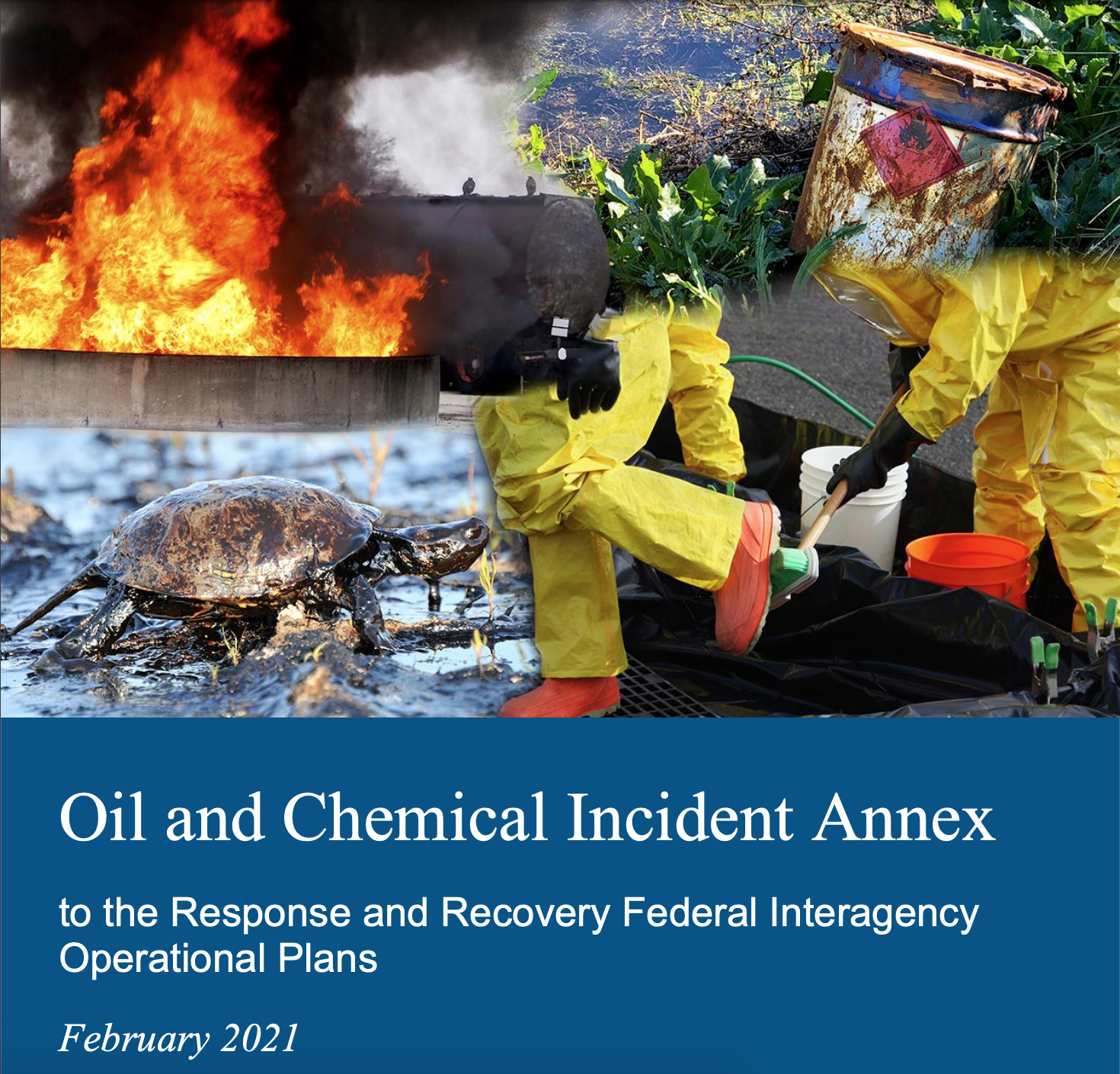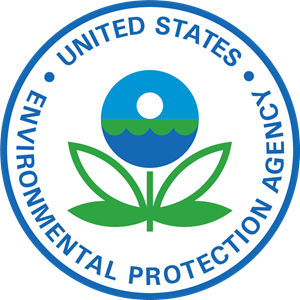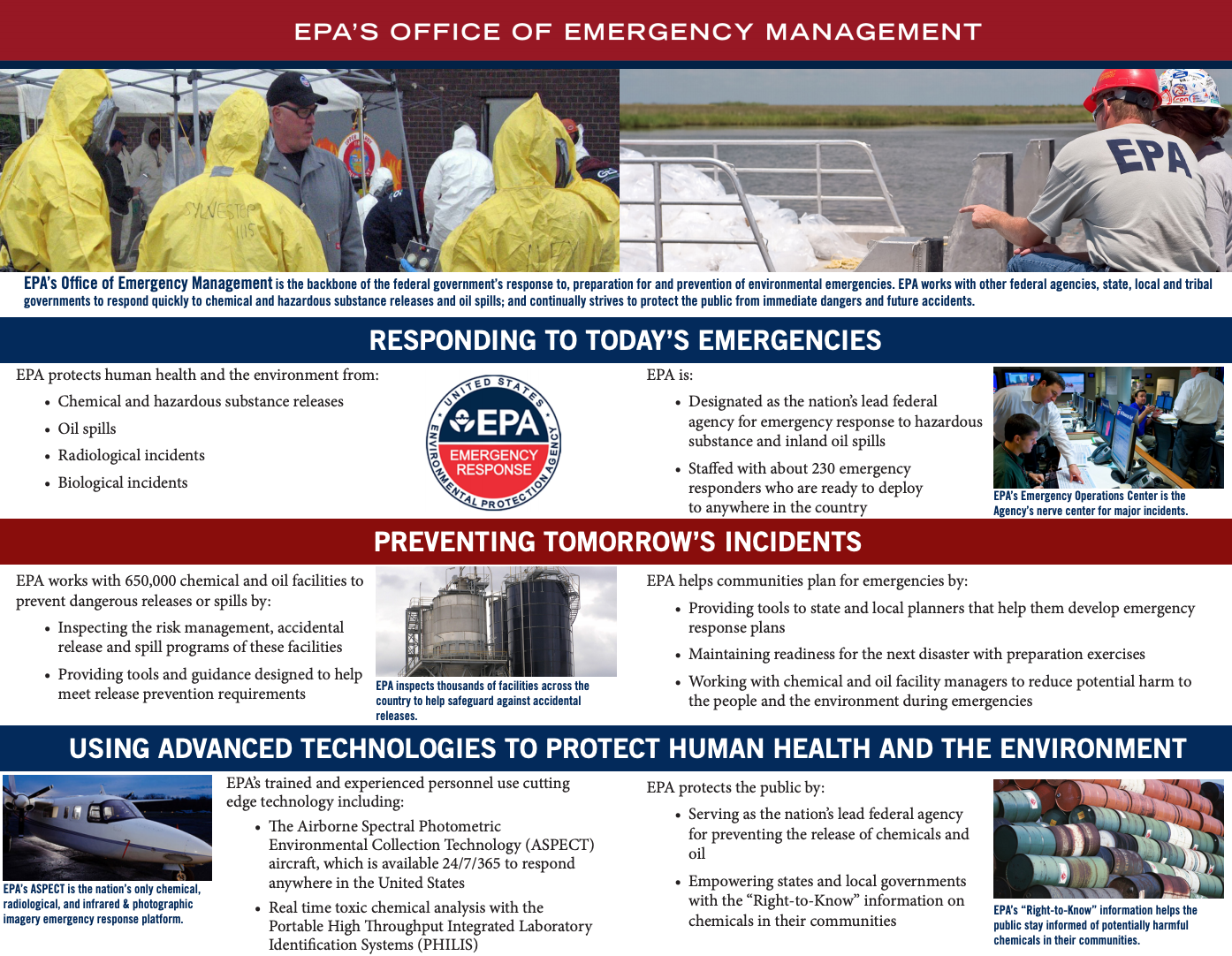FEMA’s Federal Interagency Operational Plans (FIOPs) describe how the federal government aligns resources and delivers core capabilities to implement the five National Planning Frameworks for each preparedness mission areas: preparedness, protection, mitigation, response, and disaster recovery . This webpage is based on FEMA’s Oil and Chemical Incident Annex to the Response and Recovery FIOP, which describes how federal partners will respond to oil/chemical incidents in support of Tribal governments, to save lives, protect property, and preserve the environment.
EPA’s Office of Emergency Management (OEM), which is part of EPA’s Office of Land and Emergency (OLEM), is the backbone of the federal government’s response to, preparation for and prevention of environmental emergencies. EPA is the lead federal agency for all activities following an inland oil spill or release of hazardous material or a chemical, working with other federal agencies, state, local and tribal governments to respond quickly. See the following EPA webpages for detailed descriptions of EPA’s involvement in emergency response activities:
- Learn how EPA’s OEM is organized within EPA’s OLEM along with other offices, programs, and projects at EPA’s About OLEM webpage.
- Learn more about the EPA’s OEM and its response, prevention and preparedness activities at EPA’s Emergency Response webpage.
- Learn more about EPA’s role in emergency response and coordination with other EPA programs, federal agencies, states, tribes, and local governments done through EPA’s on-scene coordinators and EPA’s special teams.
- EPA’s emergency management activities and accomplishments from around the country are highlighted on EPA’s Emergency Response and Management Activities webpage.
- See EPA’s Emergency Preparedness and Response Coordination – Who are the players and what do they do?
Want to learn more about EPA’s Roles and Responsibilities in relationship with other federal agencies?
FEMA’s Oil and Chemical Incident Annex to the Response and Recovery FIOP Appendix 7 includes EPA roles and responsibilities, individual federal officials, and emergency support functions. Additionally, FEMA’s Oil and Chemical Incident Annex to the Response and Recovery FIOP Appendix 2 provides checklists of critical federal response tasks that may be needed for situations that warrant National Oil and Hazardous Substances Pollution Contingency Plan (NCP) Unified Command Response with emergency support functions or Stafford Act Declaration.
Other federal agency offices and programs that respond to oil/chemical incidents in support of Tribal governments include:
Bureau of Indian Affairs’ (BIA) Division of Emergency Management Division (BIA EM)
Bureau of Indian Affairs’ Office of Emergency Management (BIA EM): coordinates interagency emergency management activities related to Tribal affairs to enhance preparedness and resilience of Tribal communities for disasters and to support response activities during incident. BIA EM manages and operates the National Emergency Management Tribal Assistance Coordination Group (TAC-G) to support Tribes during and after emergencies. Contact Patrick Vacha, BIA EM Acting Director, at Patrick.Vacha@bia.gov to request email notification of events, trainings, resources, and monthly call-in information.
Regional Response Teams (RRTs)
Regional Response Teams (RRTs): The U.S. National Response Team (NRT) is an organization of 15 Federal departments and agencies responsible for coordinating emergency preparedness and response to oil and hazardous substance pollution incidents. The Environment Protection Agency (EPA) and the U.S. Coast Guard (USCG) serve as Chair and Vice Chair respectively. The National Oil and Hazardous Substances Pollution Contingency Plan (NCP) and the Code of Federal Regulations (40 CFR part 300) outline the role of the NRT and Regional Response Teams (RRTs). The response teams are also cited in various federal statutes, including Superfund Amendments and Reauthorization Act (SARA) – Title III and the Hazardous Materials Transportation Act (HMTA).
Click on your area on the RRT Map to participate in an upcoming meeting, make new contacts, find training, and learn about upcoming events.
Federal Emergency Management Agency (FEMA) National Preparedness
Federal Emergency Management Agency (FEMA) National Preparedness – also see FEMA’s Tribal Affairs: The FEMA Administrator serves as the principal advisor to the President, the Secretary of Homeland Security, and the Homeland Security Council regarding emergency management.
Department of Homeland Security (DHS) Hazardous Materials Release
Department of Homeland Security (DHS) Hazardous Materials Release – also see DHS’s Tribal Resource Guide and DHS’s 2021 Action Plan for Tribal Consultation and Strengthening Nation-to-Nation Relationships: The Secretary of Homeland Security is the principal federal official for domestic incident management and is responsible for coordinating federal operations within the United States to prepare for, respond to, and recover from terrorist attacks, major disasters, and other emergencies.
US Environmental Protection Agency (EPA)
US Environmental Protection Agency (EPA): EPA is the lead federal agency for all activities following an inland oil spill or release of hazardous material or a chemical.
US Coast Guard (USCG) National Response Center
US Coast Guard (USCG) National Response Center – also see USCG Spill Response Funding/National Pollution Funds Center: The US Coast Guard is the lead federal agency for all activities in coastal and international waters following an oil spill or release of hazardous material or a chemical.
Department of Justice (DOJ)/Federal Bureau of Investigation (FBI)
Department of Justice (DOJ)/Federal Bureau of Investigation (FBI): DOJ provides expert advice on legal questions arising during an oil/chemical incident. DOJ also represents the federal government in litigation relating to hazardous substance, oil, and chemical releases. The FBI is the lead federal agency for any necessary federal law enforcement investigation related to oil/chemical incidents.
Department of Health & Human Services (HHS) Response and Recovery Resources Compendium
Department of Health & Human Services (HHS) Response and Recovery Resources Compendium – also see the Disaster Assistance Improvement Program: HHS provides federal assets and capabilities to support timesensitive, lifesaving, and life-sustaining public health and medical infrastructure to supplement Tribal response and recovery capabilities.
Department of Transportation (DOT) Emergency Preparedness, Response, and Recovery Information
Department of Transportation (DOT) Emergency Preparedness, Response, and Recovery Information: DOT through the Pipeline and Hazardous Materials Safety Administration (PHMSA) is responsible for regulating and ensuring the safe and secure movement of hazardous materials to industry and consumers by all modes of transportation, including pipelines.
Department of State (DOS)
Department of State (DOS): DOS coordinates international response and notification when discharges or releases may affect international interests or extend beyond U.S. jurisdiction. DOS also coordinates requests for response assistance from foreign governments.
Department of Energy (DOE)
Department of Energy (DOE): DOE is the primary federal agency responsible for collaborating with the energy sector on emergency response.
National Oceanic and Atmospheric Administration's (NOAA) National Ocean Service (NOS)
National Oceanic and Atmospheric Administration’s (NOAA) National Ocean Service (NOS): NOS provides a broad range of scientific, technical, and policy experts and modeling applications to support the response to an incident.
Department of Defense (DOD)
Department of Defense (DOD): DOD assists with federal actions related to oil/chemical incidents in support of domestic infrastructure. The mission of the U.S. Army Corps of Engineers (USACE) is to deliver vital public and military engineering services.
Department of the Interior (DOI) Emergency Response to Oil Spills and Hazardous Material Release
Department of the Interior (DOI) Emergency Response to Oil Spills and Hazardous Material Release and DOI’s Oil and Hazardous Substances Response: Based on its extensive land and resource management responsibilities, DOI provides scientific expertise to the federal on-scene coordinators to help protect sensitive natural, recreational, and cultural resources and areas.
Department of Labor (DOL) Occupational Safety and Health Administration (OSHA) Emergency Preparedness and Response
Department of Labor (DOL) Occupational Safety and Health Administration (OSHA) Emergency Preparedness and Response: OSHA ensures that response workers are protected and determines if response sites comply with safety and health standards; and provides consultation and enforcement to ensure adequate training, controls, and personal protective equipment for responder protection.
General Services Administration (GSA)
General Services Administration (GSA): GSA is the coordinator, with FEMA, for logistics: leases facilities, obtains transportation services (air, sea, land), and enables agencies to secure lodging for responders through its Emergency Lodging Services program; supports acquisition of emergency lodging, commodities and supplies, telecommunications services, and other needs as identified.
Nuclear Regulatory Commission (NRC) Emergency Response
Nuclear Regulatory Commission (NRC) Emergency Response: NRC regulates civilian nuclear facilities and nuclear materials and is the lead federal agency during radiological events involving its licensees and provides expertise during other radiological incidents.
FEMA’s Oil and Chemical Incident Annex to the Response and Recovery FIOP Appendix 7 includes four tables describing roles and responsibilities in the response to and recovery from an oil/chemical incident. Table 10 covers federal agencies. Table 11 (p. 73) covers individual federal officials. Table 12 (p. 74) covers Emergency Support Functions (ESFs). Table 13 (p. 77) covers nongovernmental organizations (NGOs). The tables are not exhaustive and merely represent the most prominent stakeholders and leaders; additional partners may be called upon for support depending on the situation.



